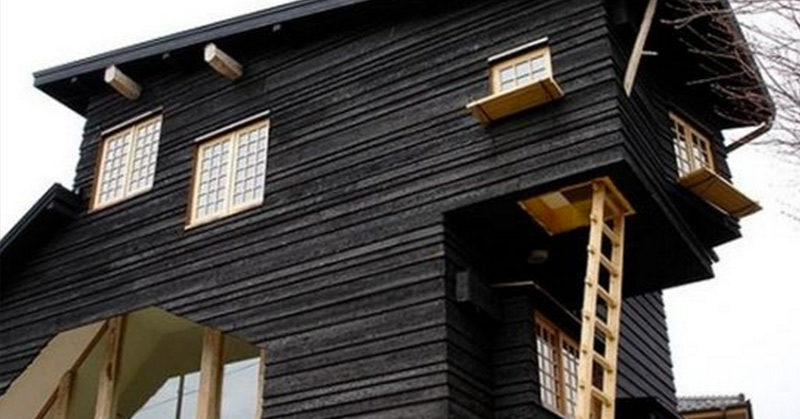One wouldn’t imagine using fire to preserve wood, but the ancient Japanese technique does just that. Shou Sugi Ban is an exterior siding method; it charrs the wood, cools it, cleans it, and finishes it with oil. Traditionally, they use Sugi wood (also called Japanese cedar).
Nowadays, Shou Sugi Ban is used as an environmentally-friendly technique to preserve wood, and counterintuitively, make it resistant to fire. More modern ways of creating this effect involve paint, retardants, and chemical preservatives. With this ancient method, all of this becomes unnecessary. Now Shou Sugi Ban is being optimized in furniture, interior rooms, and artwork.
This tradition is still popular in the Okayama Prefecture of Japan. Designers and architects went beyond Sugi wood to work with pine, douglas fir, western red cedar, and oak. Although the entire process is time-consuming, the result is gorgeous, giving the wood a silvery finish and clean, distinct lines. Not also is the wood fire-resistant and waterproof; it’s also safe from rotting, insects, and can last about 80 years.
How the Shou Sugi Ban Method Works
The process of Shou Sugi Ban draws out moisture and creates a natural chemical compound that protects the wood. It’s usually done with a blowtorch. Then a stiff brush is used to remove the carbon residue from the boards, which are rinsed with water. The final color depends on the type of wood, how long it was burned, and how hard it is brushed. The finishing oil can also be considered in its final hues.
If the charred wood furniture is kept inside with minimal handling, it will need little to no maintenance. If it’s kept outside, it should be oiled about every 10 years. Another form of maintenance can include a quickly hand-sanding if needed, but all this is fairly standard for wooden pieces.
The aesthetics of Shou Sugi Ban pieces can depend on the wood you choose to work with, how deeply you torch it, how hard you brush, and the finish you use. You can always stain it if so desired instead of using oil. Colors often range from a rich brown to an inky black. [1]
Shou Sugi Ban isn’t the first environmentally-friendly method of woodworking to come from Japan. Daisugi is a forestry technique created there that produces lumber without chopping down trees. It’s another example of ingenuity working with sustainability.
Step by Step: How to Use the Shou Sugi Ban Method
Choose your wood.
According to Hugh Shackleton of Shackleton Thomas furniture makers in Bridgewater, Vermont, cedar is the best wood to work with.
“Cedar is a lighter, more porous wood,” he said. “There’s a chemical component to it which makes it work better for this technique. In this particular design, the bottom is basswood, which still works, but cedar takes it better.”
However, he said that pine, hemlock, oak, or maple wood work as well.
Burn the wood.
Pyromaniacs, it’s time to shine. Using a blowtorch or an ice melting torch for larger pieces, start charring. This is the crown of the Shou Sugi Ban process.
“Char the surface enough so that it eats into the wood,” Hugh said. “When the wood starts to separate like you’d see on a log in your fireplace, it’s done. End grain burns slower than face grain, so pay particular attention to the sides of the piece as you go.”
Ensure you are moving the torch evenly over the wood, for about 5–10 seconds in each spot. After it turns black and sooty, move on. Work in a well-ventilated area without any flammable objects nearby. Outside is ideal.
Wire brush the wood.
Take a standard wire brush, sweep off the soot created during the burning process. Move in the direction of the grain until you uncover the deep brown color underneath.
“You need to be prepared for the characteristic change in the wood,” said Hugh. “Once you wire brush it, it opens up the wood. It becomes more porous.”
Clean the wood.
If you own an air compressor, use it to clean the wood. If not, a simple dampened cloth will do. Wipe down the entire piece and wait for it to dry completely for moving on.
Oil the wood.
When the wood is dry, apply liberal amounts of oil and rub it into the grain with a rag. Once again, follow the natural pattern of the grain. Allow the wood to dry again and then give it a second coat to any dry-looking areas. You may also desire to use the torch to seal in the oil after these coats. [2]
Shou Sugi Ban: It Takes Time, but it’s Worth it
Although the Shou Sugi Ban technique may seem daunting at force, with a little practise, it’s easier than you think. Plus the aesthetic of the wood is stunning every time.
Keep Reading: China is Turning the Rainforest into Cheap Furniture for the US
- Lydia Paradis Bolduc. “SHOU SUGI BAN CARBONIZED WOOD SIDING FROM JAPAN, WHAT IS IT & HOW TO MAKE IT?” Eco Home. January 18, 2017
- Katherine Cooper. “Use This Incredible Technique to Waterproof Wood Furniture.” Architectural Digest. November 3, 2017

